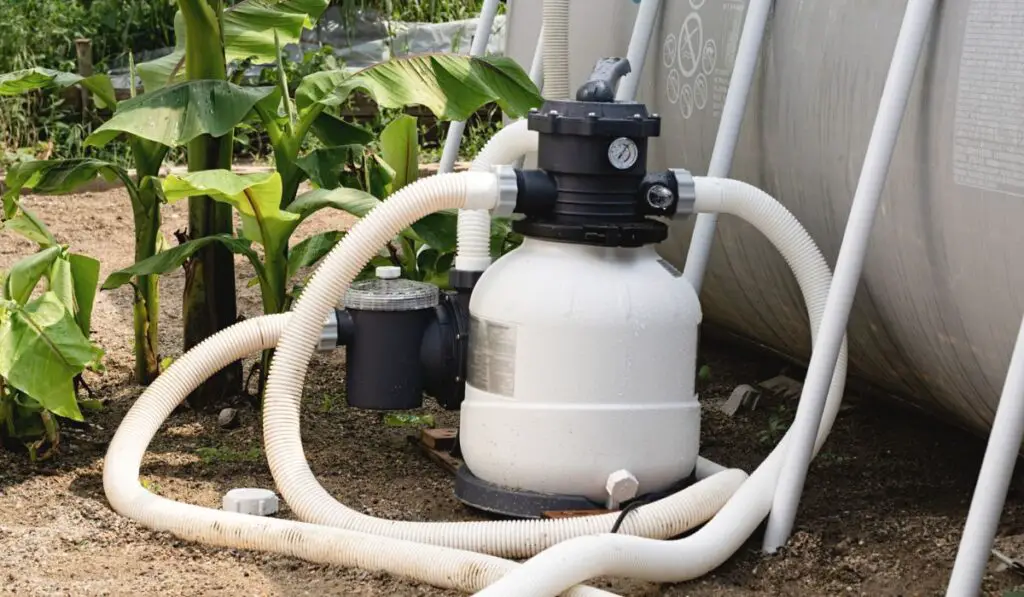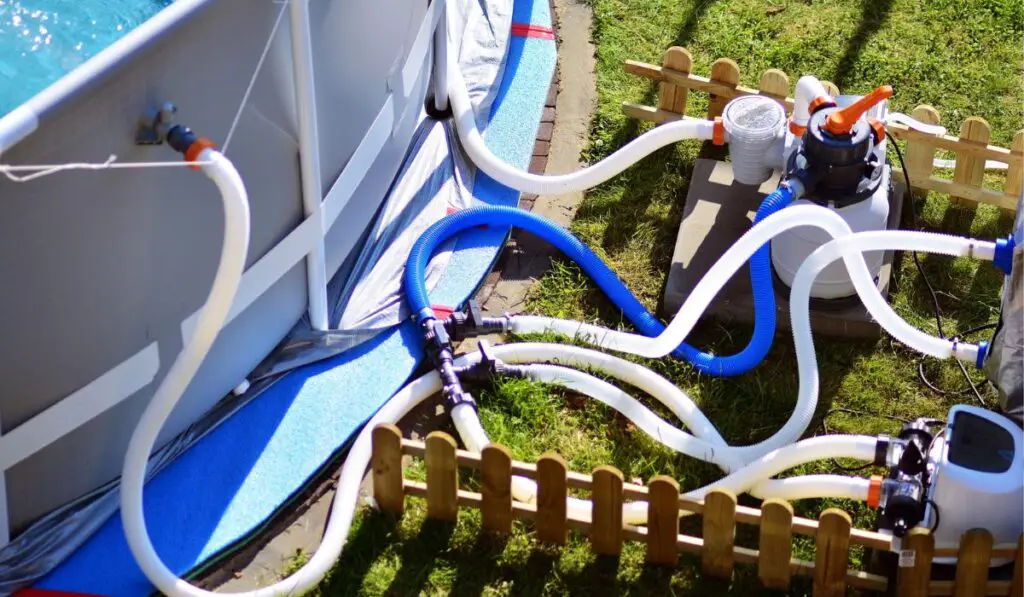Pool pumps work with pool filters to prevent algae growth and clean any dust or debris that’s collected in your pool. However, with so much advice floating around on the web, it can be difficult to determine the best time to run your pump.
It’s best to run your pool pump during the warmest part of the day, as it will help eliminate more contaminants and prevent chlorine loss. However, if you want to cut down on power costs, then you can run the pump at night. Run the pump 24/7 if you’ve just filled the pool or if it’s extremely dirty.
If you’re planning on relaxing in your swimming pool for many years to come, then it’s important to prioritize pool cleaning and maintenance. Let’s look at how pool pumps actually work, whether you should run them during the day or night, and if they use a lot of electricity.
How Do Pool Pumps Work?

Pool pumps like this VEVOR model (on Amazon) are an extremely important part of a pool’s circulation system. They have three main components:
- Pump basket: collects leaves, branches, and other large debris.
- Impeller: a fan-like mechanism that ensures water circulation.
- Water discharge: a connection point that sucks in water from the pool pump and pushes it into the filter’s housing.
And if you’re looking at this short list and trying to figure out what you have at your pool, note that many pool pumps like this model from Intex (also on amazon) come tightly integrated with a sand filter that will be nearby. They may seem like one device to you at first!
In a typical pool pump, an electric motor powers the impeller located inside the pump’s housing. The impeller draws in water from all the different drains in your pool, passes it through the filtration system, and then pushes it back out through the water inlets.
Just before the water flows into the pool pump, it passes through the strainer basket to prevent any large debris from clogging and damaging the pump.
The pump also pushes the water to the filtration system to remove dirt, germs, and other small debris from the pool. Lastly, once the water is filtered, the pump pushes it back out to the pool through the outlet pipe.
What Time of Day Is Best to Run a Pool Pump?
It’s best to run your pool pump during the warmest part of the day. However, keep in mind that this will result in higher energy consumption and a significant increase in your electricity bill.
If you want to cut down on energy costs, you can turn on the pool pump at night after peak hours. You can even run the pump overnight when the swimming pool isn’t in use. This way, you’ll be able to dive into a clean swimming pool first thing in the morning!
It’s important to note that there’s no fixed time of day you need to follow. In fact, you can run your pool pump during both the day and the night. Instead of running the pump in a single continuous block, you can just turn it on for a couple of hours during the day and then for a few hours at night.
Running the Pool Pump During the Day
It’s best to run your pool pump during the day because this is the time when your swimming pool is most susceptible to contaminants, chlorine loss, and algae bloom.
Once the sun comes out, the UV rays promote algae growth and burn up the chlorine in your pool. However, running the pump can help circulate the water and treatment chemicals, preventing the growth of algae in your pool.
It’s also important to note that most people swim during the day. When you use your pool, you introduce several different contaminants such as urine, body care products, body oils, food residue, and sweat into the pool water. All these contaminants then accumulate and increase chlorine usage.
For this reason, it’s best to turn on the pump after using your pool, so the water can be properly circulated and passed through the filtration system.
The cartridge filters will then remove all the contaminants from the water, ensuring a germ-free pool for your next swim.
Also, these contaminants, along with the chlorine loss, mean that your pool is the perfect breeding ground for algae and bacteria during the day. So, it’s best to turn on your pool pump for six to eight hours after the sun comes out.
Running the Pool Pump at Night
Running the pump after the sun has set has a few advantages as well. You can turn on the pump at night if you’ve shocked the swimming pool or want to cut down on your energy costs.
Run the Pump at Night After Shocking
If you’ve shocked your pool or added any chemicals to the water, then it’s best to turn on the pump for at least eight hours at night.
It’s also better to add chemicals to the pool water at night, as it maximizes their efficiency. In fact, shocking the pool or adding chemicals during the day will result in the sun’s UV rays burning off the chemicals and reducing their effectiveness.
After you add chemicals, make sure you turn on the pump so that the water is properly circulated and the chemicals are fully dispersed throughout the pool.
Run the Pump at Night to Cut Down Power Costs
In most areas, there’s usually a reduction in energy costs between 9 pm and 8 am. So, running your pool pump at night will be less expensive than running it during the daytime. In fact, you could save up to 60% by running the pool pump at night.
Is It Okay to Run a Pool Pump 24 Hours a Day?
On average, you should turn on your pool for around six to eight hours per day in the winter and 10 to 12 hours in the summer.
However, there are a few circumstances when you’ll have to run your pool pump 24 hours a day:
When the Water Has Algae or Is Dirty
If the water is partially dirty or there’s a lot of algae in your pool, then you’ll need to run the pump 24/7. The continuous water circulation will make it easier for the filtration system to trap all contaminants, ensuring a faster clean-up process.
Even if you shock the pool or add algaecide, running the pump for around eight hours a day won’t be enough to eliminate algae or clear the cloudy water. Instead, you’ll need to keep running the pump and filter until the pool water is completely clear.
When You’ve Just Filled Your Pool
It’s best to run the pump 24 hours a day after filling up the pool, as this will allow the filter to capture and eliminate any contaminant that’s in the water.
Once you’ve filled your pool with water, make sure you run the pump continuously for a few days to enable proper water circulation, especially if you’ve just filled your pool with well water.
Do Pool Pumps Use a Lot of Electricity?

According to Opower, houses with swimming pools use about 49% more electricity per year than houses without pools. This increase in energy consumption translates to around $500 per home each year.
That means that pool pumps do, in fact, use a lot of electricity. In fact, pools collectively use around 9-14 billion kilowatt-hours of electricity annually in the United States.
It’s important to note that the average swimming pool holds around 20,000 gallons of water, and a pool pump uses about 2,500 KWh each year to circulate and clean it.
If you put these numbers into perspective, you’ll find that after the air conditioner, the pool pump is the biggest energy consumer in an average pool-containing house.
